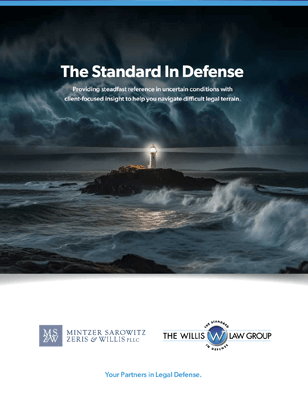Maryland’s Highest Court Upholds Trial Court’s Decision to Give Spoliation Jury Instruction
Sep 1, 2020 - News by Ashley Friedman
Maryland’s Highest Court Upholds Trial Court’s Decision to Give Spoliation Jury Instruction
 (August 25, 2020) In its July 27, 2020 opinion in Steamfitters Local Union No. 602 v. Erie Ins. Exch.. and Steamfitters Local Union No. 602 v. Cincinatti Ins. Co., Maryland’s highest court upheld the trial court’s decision to give a spoliation jury instruction. The case stemmed from an April 16, 2015, fire that started on a property owned by Steamfitters Local Union No. 602, in Capital Heights, Maryland, and subsequently spread to the neighboring properties, owned by Gordon Contractors, Inc. (“Gordon”), and Falco Industries, Inc., C&M Properties LLC, C&M Properties Delaware, LLC, and Garage Center LLC (collectively referred to as “Falco”). The fire started in a mulched strip of common area that ran along the boundary line between Steamfitters’ property and a commercial construction yard owned by Gordon. Steamfitters’ apprentices regularly congregated for hours at a time in and near the mulched area before the start of classes held in the union hall. The mulch bed was ten feet wide and ran approximately 200 feet along the fence between Steamfitters’ parking lot and Gordon’s yard. The mulch bed consisted of shredded wood mixed with dead pine needs from trees planted in the bed. During the investigation into the cause of the fire, hundreds of cigarette butts that had been discarded in the mulched area were discovered.
(August 25, 2020) In its July 27, 2020 opinion in Steamfitters Local Union No. 602 v. Erie Ins. Exch.. and Steamfitters Local Union No. 602 v. Cincinatti Ins. Co., Maryland’s highest court upheld the trial court’s decision to give a spoliation jury instruction. The case stemmed from an April 16, 2015, fire that started on a property owned by Steamfitters Local Union No. 602, in Capital Heights, Maryland, and subsequently spread to the neighboring properties, owned by Gordon Contractors, Inc. (“Gordon”), and Falco Industries, Inc., C&M Properties LLC, C&M Properties Delaware, LLC, and Garage Center LLC (collectively referred to as “Falco”). The fire started in a mulched strip of common area that ran along the boundary line between Steamfitters’ property and a commercial construction yard owned by Gordon. Steamfitters’ apprentices regularly congregated for hours at a time in and near the mulched area before the start of classes held in the union hall. The mulch bed was ten feet wide and ran approximately 200 feet along the fence between Steamfitters’ parking lot and Gordon’s yard. The mulch bed consisted of shredded wood mixed with dead pine needs from trees planted in the bed. During the investigation into the cause of the fire, hundreds of cigarette butts that had been discarded in the mulched area were discovered.
The fire spread along the chain-link fence that separated Steamfitters’ property from the Gordon property and ignited foam insulation that was stored against the fence on Gordon’s side. This insulation liquefied, causing further spread, and ultimately the fire engulfed multiple vehicles on the Gordon property, as well as the contents of a large dumpster. Before it was extinguished, the fire also spread to the Falco property, which was on the other side of the Gordon property. Gordon and its insurers, Erie Insurance Exchange and Continental Casualty Company, filed a complaint against Steamfitters in the Circuit Court for Prince George’s County on December 14, 2015, alleging a single count of negligence and seeking damages of $1,276,200.24. Cincinnati Insurance Company, as the subrogee of Falco, filed a complaint against Steamfitters in the Circuit Court for Prince George’s County on March 4, 2016, also alleging a single count of negligence. The cases were consolidated in April 2016. As such, the collective Plaintiffs were Gordon and its insurers, and Falco and its insurer. Gordon and Falco did not allege that Steamfitters was vicariously liable or that it had a duty to control an unknown person who discarded a cigarette. Instead, Gordon and Falco proceeded on the theory that Steamfitters, as the property owner, failed to use reasonable care to prevent the foreseeable risk of fire spreading to nearby properties.
The case was tried before a jury from July 17-20, 2017. At trial, Lt. Wayne Crosby of the Prince George’s County Fire Marshal’s Office, who was the lead investigator on the fire, testified as an expert in fire origin, cause, growth, and spread. As part of the Fire Marshal’s Office’s investigation into the cause of the fire, they canvassed the area to obtain videos from building-mounted cameras as well as cell phone cameras. The Fire Marshal’s Office identified three building-mounted cameras that might have captured relevant information: a surveillance camera on the Falco property, a camera affixed to the exterior of a church across from Steamfitters’ property, and a camera on the exterior of the Steamfitters’ building. The camera on the exterior of Steamfitters’ building pointed close to the area where the fire was alleged to have originated. Although Lt. Crosby requested the video recording from the camera affixed to the Steamfitters’ building, he did not receive it. The Plaintiffs sent a litigation hold letter to Steamfitters on April 23, 2015, and counsel for Steamfitters responded to the letter prior to the destruction of the video tape. In addition, Steamfitters failed to produce the video during discovery, and it was undisputed that the video was taped over and destroyed 30 days later. There was evidence presented at trial which showed that on separate occasions, both Lt. Crosby and Erie’s claims adjuster, Dustin Sclater, asked for the video before it was destroyed. The trial court gave the jury the standard spoliation instruction that addressed both negligent and intentional spoliation of evidence, and the Court of Special Appeals held that the trial court did not abuse its discretion in giving the spoliation instruction.
Steamfitters argued that the trial court’s spoliation instruction was erroneously given because the plaintiffs failed to prove that the video was relevant and because the instruction was unfairly prejudicial. They also averred that an insurance claims adjuster employed by Erie reviewed the tape, advised that it was useless, and declined a copy on a thumb drive prior to the destruction of the recording. Steamfitters further argued that the spoliation instruction was improper because the taped-over footage was not relevant evidence. Respondents, plaintiffs below, countered that Steamfitters grossly mischaracterized the evidence. They asserted that the video contained highly-relevant footage that would have supported their theory of the case. Specifically, they argued that the video contained footage of union apprentices smoking cigarettes on Steamfitters’ property, near the place where the fire must have started. Respondents also argued that Steamfitters could not challenge the portion of the instruction pertaining to intentional spoliation because they failed to object on those grounds at trial and instead, made only a general relevance objection.
The Court of Appeals agreed with the Court of Special Appeals that the trial court did not abuse its discretion in giving the instruction. The Court noted that there was evidence in the record that the camera was pointed in a direction that would have recorded persons present on Steamfitters’ property prior to and at the time of the fire, as well as a portion of the property close to the origin of the fire. Video of that area might have also recorded other evidence similar to the evidence captured by the other two video cameras, which were shown to the jury, such as the color of the smoke, wind direction and speed.
The Court explained that it is for the jury to determine whether the destruction of evidence was merely the product of mistake or whether the alleged spoliator intentionally destroyed the evidence. Anderson v. Litezenburg, 115 Md. App. 549, 561 (1997). The evidence was subject to different interpretations as to why Steamfitters did not preserve the video recording. The Court further explained that it was for the jury to consider Steamfitters’ explanation of why it failed to preserve this evidence, to judge the credibility of witnesses, and to draw inferences therefrom. As such, the Court held that the trial court did not abuse its discretion in giving the spoliation instruction.
The Court next turned to whether Steamfitters could challenge the portion of the instruction pertaining to intentional spoliation. The Court first noted that Maryland Rule 2-520(e) provides that “[n]o party may assign as error the giving or the failure to give an instruction unless the party objects on the record promptly after the court instructs the jury, stating distinctly the matter to which the party objects and the grounds of the objection.” The Court further explained that this rule requires an objecting party to “be precise in stating objections to jury instructions at trial, for the plain reason that the trial court has no opportunity to correct or amplify the instructions for the benefit of the jury if the judge is not informed of the exact nature and grounds of the objection.” Fearnow v. Chesapeake & Potomac Tel. Co. of Md., 342 Md. 363, 378 (1996). The Court agreed with the Court of Special Appeals that Steamfitters did not specifically raise with the trial judge the issue of the instruction’s reference to intentional spoliation, and as such, the issue was not preserved on appeal.
It is clear from the Court of Appeals’ opinion that where there is evidence in the record that evidence was not properly preserved, it is not an abuse of discretion by the trial court to give the jury an instruction on spoliation, and that in order to properly preserve an objection to such an instruction, the objecting party must clearly and specifically state which portions of the instruction to which he or she is objecting, and the grounds for that objection.



